Tribunal Statistics Quarterly: January to March 2022
Published 9 June 2022
1. Main Points
This publication presents tribunals statistics for the latest quarter (January to March, Q4 2021/22), compared to the same quarter the previous year, alongside annual data for 2021/22.
This publication does not include receipts, disposal and caseload outstanding figures for the Upper Tribunal Immigration and Asylum Chamber (UTIAC), Employment Appeal Tribunal (EAT), or Q1 2021/22 (and therefore 2021/22) data for the Employment Tribunal (ET) due to these tribunals being migrated to new case management systems. The data will be made available as soon as possible, and once the data is quality assured. The total of the remaining jurisdictions is referred to in this publication and accompanying tables as the ‘Interim Total’ and has been provided to allow comparisons over time.
Employment Tribunal (ET) receipts, disposals and caseload outstanding data is now available following the transition to a new case management database during March to May 2021. It has not been possible to provide the full results from both databases during this migration period on a consistent basis. Due to operational differences between Employment Case Management (ECM) and Ethos (the previous database), caution should be exercised when making comparisons in the statistical results before and after migration. The summary table below presents statistics for the 2021/22 financial year, compared to the previous financial year (2020/21).
| The interim[footnote 1] overall volume of receipts and caseload outstanding have increased, and disposals have decreased | Her Majesty’s Courts & Tribunals Service (HMCTS) recorded an increase of 19% in the interim[footnote 1] totals for receipts in 2021/22 compared to the previous financial year. Disposals interim1 total decreased by 9%. Caseload outstanding interim[footnote 1] total increased by 17%. However, compared to 2019/20 (pre-pandemic) the interim[footnote 1] totals for receipts, disposals, and caseload outstanding decreased by 23%, 37%, and 13% respectively. |
| SSCS receipts and caseload outstanding increased and disposals decreased | In 2021/22, Social Security and Child Support (SSCS) receipts and caseload outstanding increased (by 2% and 8% respectively) when compared to 2020/21. A 39% increase in Universal Credit (UC) mainly drove the rise in receipts. SSCS disposals decreased by 33% over the same period. The decrease in disposals was driven by a 37% decrease in PIP disposals. |
| FTTIAC receipts, disposals and caseload outstanding all increased | FTTIAC receipts, increased by 51% in 2021/22 compared to the previous financial year. Disposals and caseload outstanding also increased (by 98% and 16% respectively) over the same period. Compared to 2019/20 (pre-pandemic), receipts and disposals decreased by 7% and 19% respectively, and caseload outstanding increased by 43%. |
| Single ET claims received declined Multiple ET claims decreased |
Single Employment Tribunal (ET) receipts, disposals, and caseload outstanding all decreased by 11%, 6% and 4% respectively in Q4 2021/22, compared to the same period a year ago. In Q4 2021/22, Multiple ET receipts decreased by 40% compared to the same period a year ago. Disposals and caseload outstanding increased by 170% and 1% respectively, over the same period. |
| Decreases in adjournments and postponements | In 2021/22, the adjournments reported on decreased by 14%, compared to 2020/21, driven by SSCS, which makes up most adjournments (70%). Postponements decreased 4% over the same period. Mental Health and SSCS made up 36% and 30% respectively of Postponements. |
For feedback related to the content of this publication, please contact us at CAJS@justice.gov.uk
2. Statistician’s Comment
In general, and as in other non-criminal jurisdictions, tribunal receipts are increasing but haven’t reached pre-Covid19 levels. However, there are a few notable exceptions to this: SSCS receipts remain low compared to pre-Covid19 levels, and special tribunals are the highest recorded in our series – which is driven by an increase in the First-tier Tax Chamber, where receipts quadrupled between 2020/21 and 2021/22.
Where receipts have increased but sittings haven’t increased commensurately, this has led to increased caseload outstanding in a number of tribunals, particularly in the First-tier Tax Chamber, Special Educational Needs and Disability and the First-tier Tribunal (Immigration and Asylum Chamber) tribunals (where caseload outstanding had increased compared to the year previously by 49%, 24%, and 16% respectively).
Receipts to the Gender Recognition Panel increased by 72% between 2020/21 and 2021/22, following a reduction of the application fee in May 2021. A full Gender Recognition Certificate was granted in nearly five hundred cases over the year.
3. Overview of Tribunals
In 2021/22 receipts interim[footnote 1] total was 218,000 and disposals interim[footnote 1] total was 202,000
HMCTS recorded a 19% increase in the interim[footnote 1] total for receipts and a 9% decrease in the interim[footnote 1] total for disposals in 2021/22, when compared to the previous financial year. Caseload outstanding interim[footnote 1] total increased by 17%, to 133,000, over the same period.
This publication does not include Upper Tribunal (Immigration and Asylum Chamber) data for Q2, Q3, and Q4 of 2021/22, Employment Tribunals data for Q1 2021/22 and Employment Appeal Tribunal (EAT) data for 2021/22 due to database migration as stated above. The total of the remaining jurisdictions is referred to in this publication and accompanying tables as the ‘Interim Total’ and has been provided to allow year-on-year comparisons over time. The interim[footnote 1] total makes up 52% of receipts caseload, 55% of disposals caseload and 23% of caseload outstanding when compared to the average case types over the previous 5 financial years.
This summary bulletin focuses mainly on the Social Security and Child Support (SSCS) tribunal, the First-tier Tribunal Immigration and Asylum Chamber (FTTIAC), and the Employment Tribunal as they made up the majority (75%) of all receipts in January to March 2022:
-
Social Security and Child Support (SSCS) – 42% of receipts
-
Employment Tribunal (ET) – 23% of receipts
-
First Tier Tribunal Immigration and Asylum Chamber (FTTIAC) – 10% of receipts
In 2021/22, the receipts interim[footnote 1] total increased by 19% and disposals interim[footnote 1] total decreased by 9% compared to 2020/21 (to 218,000 and 202,000 respectively). Disposals interim[footnote 1] total is at the lowest recorded level since reporting began in 2007/08. Caseload outstanding interim[footnote 1] total increased by 17% over the same period and stood at 133,000 at the end of March 2022. This was mostly driven by increases in FTTIAC, SSCS and the First-tier Tax Chamber (by 16%, 8% and 49% respectively).
Figure 3.1: Receipts interim totals, Q4 2017/18 to Q4 2021/22 (Source: Tables S_2)
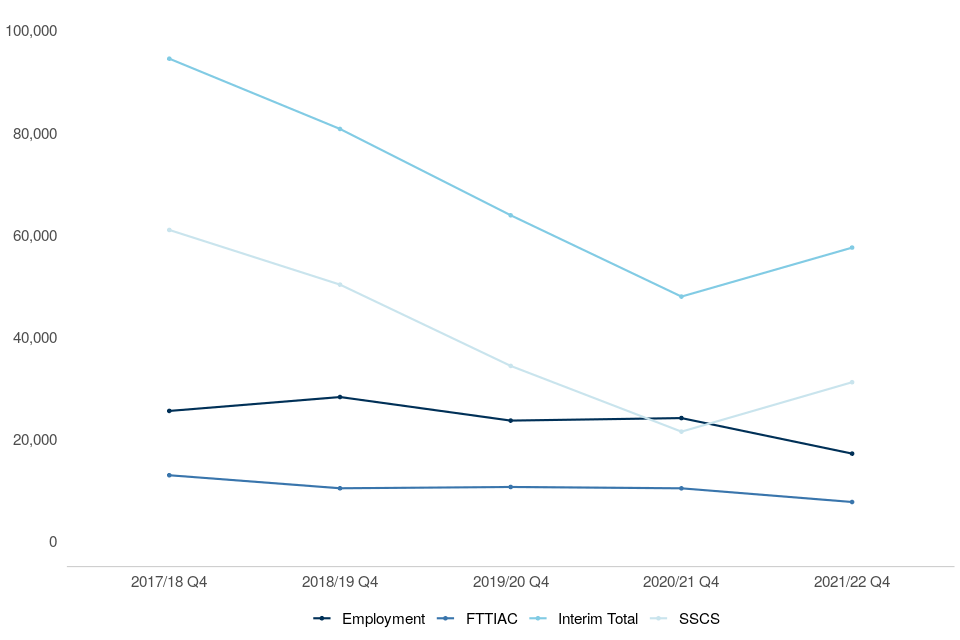
Figure 3.2: Disposals interim totals, Q4 2017/18 to Q4 2021/22 (Source: Tables S_3)

Figure 3.3: Caseload outstanding[footnote 2] interim totals, Q4 2017/18 to Q4 2021/22 (Source: Tables S_4)

The charts above show the trends in receipts, disposals and caseload outstanding over the last five years for SSCS, FTTIAC, ET, and all tribunals overall (using the Interim Total measure).
In January to March 2022, receipts increased by 20% compared to January to March 2021. This was driven by an increase in SSCS, of 45% to 31,000 receipts respectively. This rise is largely due to case levels returning to normal following the impact of the COVID-19 pandemic and related government actions to mitigate the effects on society in the previous financial year.
Overall Disposals decreased by 12% in January to March 2022 compared to January to March 2021. Compared to Q4 2019/20, which was pre-Covid19, the volume decreased by 31%. The FTTIAC disposed of 51% more cases in Q4 2021/22 compared to Q4 2020/21. The rise was offset by a 34% decrease in SSCS disposals.
4. Social Security and Child Support
SSCS receipts and caseload outstanding increased, and disposals decreased in 2021/22 compared to the previous financial year
In 2021/22, Social Security and Child Support (SSCS), receipts and caseload outstanding increased by 2% and 8% respectively compared to 2020/21. Disposals decreased by 33%.
In 2021/22, 62% of disposals were cleared at hearing with a 61% overturn rate
Of the 92,000 disposals in 2021/22, 62% were cleared at a hearing and of these, 61% had the initial decision revised in favour of the claimant (down from 67% and 70% in 2020/21 respectively).
Figure 4.1: Social Security and Child Support receipts, Q4 2017/18 to Q4 2021/22 (Source: Tables SSCS_1)
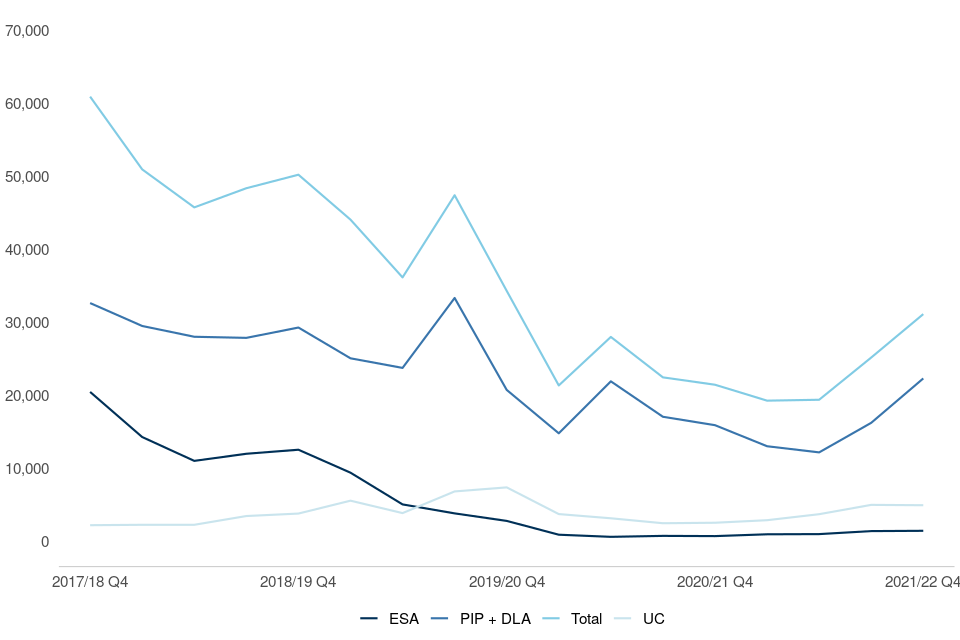
Figure 4.2: Social Security and Child Support disposals, Q4 2017/18 to Q4 2021/22 (Source: Tables SSCS_2)
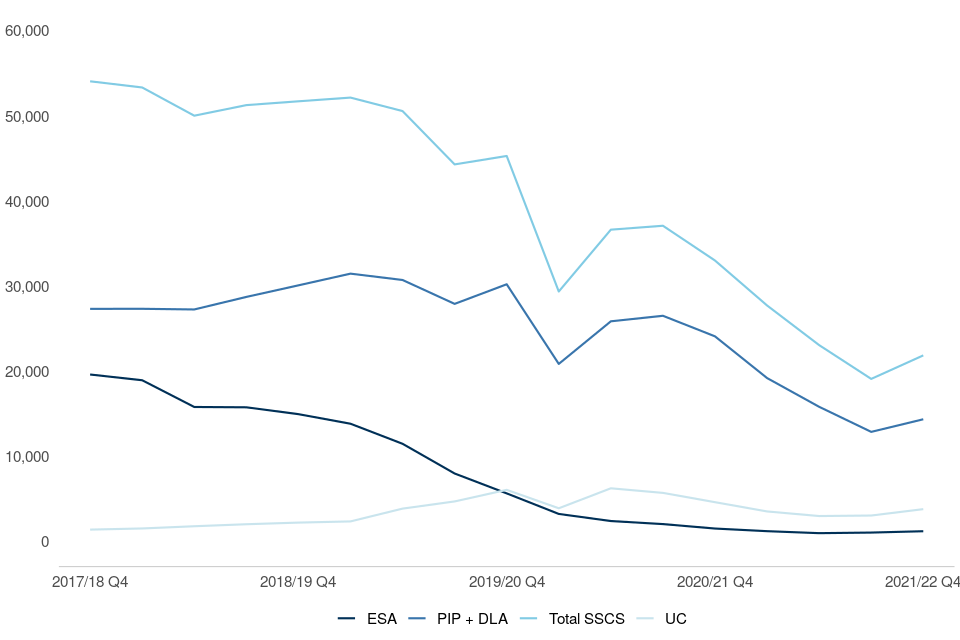
Figure 4.3: Social Security and Child Support caseload outstanding, Q4 2017/18 to Q4 2021/22 (Source: Tables S_4)
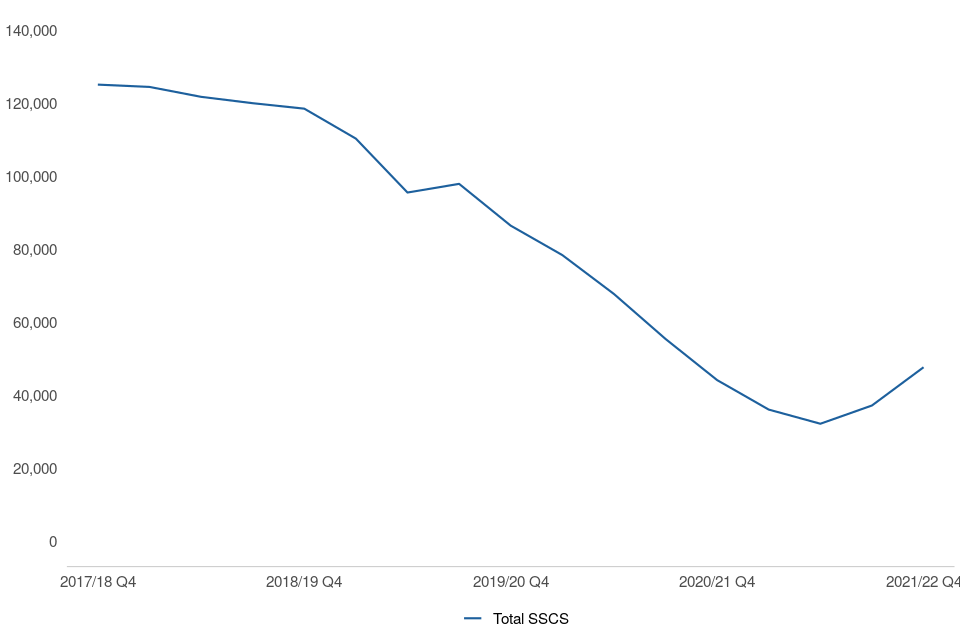
The economic impact of the COVID-19 pandemic resulted in an increase in the number of people on Universal Credit[footnote 3] as the employment rate decreased and economic inactivity increased. The Department for Work and Pensions (DWP) changes to benefit processes in response to the pandemic, such as the temporary suspension of face-to-face assessments for health and disability-related benefits, contributed to the general downward trend in receipts seen during the pandemic. However, as the policies put in place due to COVID-19 come to an end and restrictions are eased, we are now seeing SSCS receipts return to pre-Covid19 levels.
In 2021/22, there were 95,000 SSCS receipts, an increase of 2% compared to 2020/21. Over the same period, disposals decreased by 33% to 92,000 in 2021/22. Caseload outstanding stood at 48,000 at the end of the 2021/22 financial year (March 2022), an increase of 8% compared to the same time last year.
Over the last quarter, there were increases in the employment rates and decreases in the unemployment rates and subsequently SSCS tribunal receipts increased by 45% this quarter, to 31,000 appeals, compared to January to March 2021. This was driven by a 44% increase and 95% increase in Personal Independence Payments (PIP) and Universal Credit (UC) respectively. PIP and UC appeals accounted for 67% and 16% respectively of all SSCS receipts in January to March 2022. Universal Credit is available to people who are in work and on a low income, as well as to those who are out of work.
In January to March 2022, SSCS disposals decreased by 34% when compared to the same period in 2021 (from 33,000 in Q4 2020/21 to 22,000 in Q4 2021/22). PIP made up over half of SSCS disposals (60%).
Of the disposals made by the SSCS Tribunal, 13,000 (58%) were cleared at hearing, and of these, 63% were overturned in favour of the customer (both down from 66% on the same period in 2021). This overturn rate varied by benefit type, with PIP at 72%, Disability Living Allowance (DLA) 63%, Employment Support Allowance (ESA) 62%, and UC 55%. Compared to January to March 2021, DLA and ESA overturn rates both decreased by 5 percentage points, while PIP and UC remained similar.
There were 48,000 SSCS cases outstanding at the end of March 2022, an increase of 8% compared to the same period in 2021. This reverses the fall that began in Q4 2018/19 (when comparing to the same quarter in the previous year). Since Q4 2017/18, caseload outstanding has been gradually decreasing (from a peak of 125,000), only rising in Q3 2019/20 and the last two quarters (Q3 and Q4 2021/22).
Of those cases disposed of by the SSCS tribunal in January to March 2022, the mean age of a case at disposal was 26 weeks, a 5 week decrease than for the same period in 2021 (see tables T_2) and 2020.
5. Immigration and Asylum
First-tier Tribunal Immigration and Asylum Chamber (FTTIAC)
In 2021/22, FTTIAC receipts increased by 51%, to 39,000, compared 2020/21. Disposals increased by 98% (to 40,000), over the same period.
In the same period, caseload outstanding increased by 16% (to 28,000).
Figure 5.1: First-tier Tribunal Immigration and Asylum Chamber receipts, Q4 2017/18 to Q4 2021/22 (Source: Tables FIA_1)
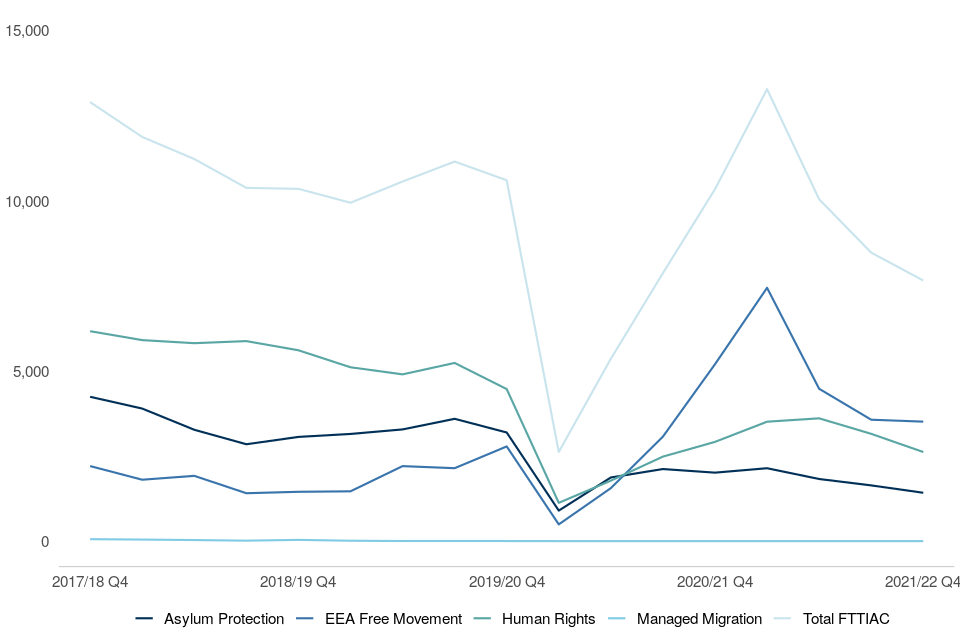
Figure 5.2: First-tier Tribunal Immigration and Asylum Chamber disposals, Q4 2017/18 to Q4 2021/22 (Source: Tables FIA_2)
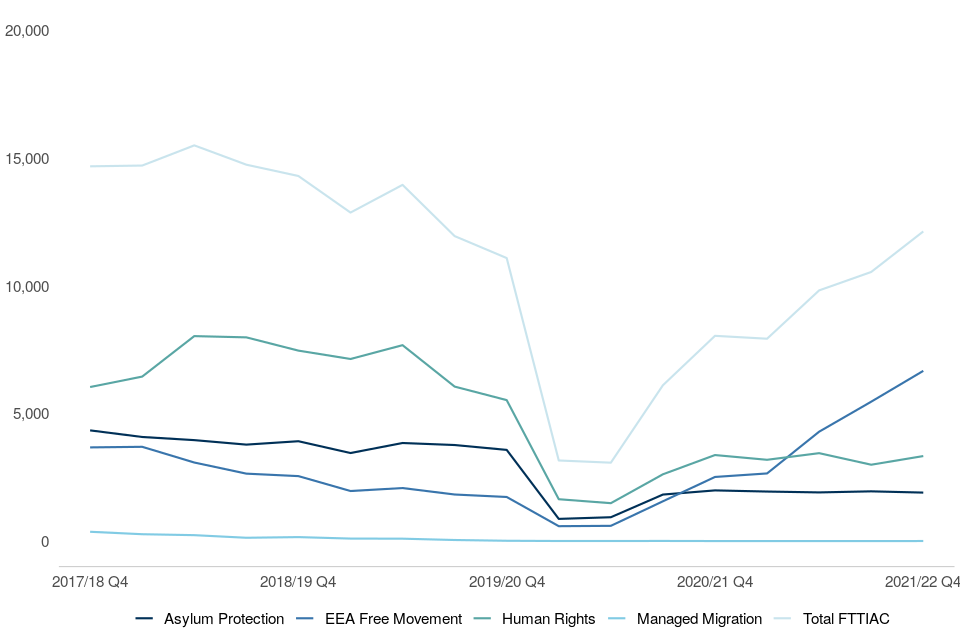
Figure 5.3: First-tier Tribunal Immigration and Asylum Chamber caseload outstanding, Q4 2017/18 to Q4 2021/22 (Source: Tables S_4)

Following on from a steep fall in 2020/21 due to the impact of the pandemic, FTTIAC receipts have been returning to pre-Covid19 levels. In 2021/22, FTTIAC receipts increased by 51% (to 39,000) compared to 2020/21. However, receipts remain lower with 7,700 receipts in Q4 2021/22, a decrease of 26% and 28% when compared to the same period last year and the pre-Covid19 period respectively.
The proportion of EEA/EUSS receipts has been increasing steadily since the EUSS route closed in June 2021, now making up 46% of all FTTIAC receipts In January to March 2022, there were 3,500 EEA/EUSS receipts, a decrease of 32% compared to the same period last year. However, overall in the financial year 2021/22 there were a total of 19,000 EEA/EUSS receipts, 84% higher than 2020/21, and the highest level since 2015/16 when reporting began.
Compared to Q4 2020/21, Human Rights (HR) receipts decreased by 10% to 2,600. However, figures for the financial year shows an increase in HR receipts when compared to 2020/21. In 2021/22 there were 12,900 HR receipts, an increase of 55% compared to 2020/21. Asylum/Protection (AP) receipts decreased by 29% compared to the same period in 2021 (to 1,400). HR and AP proportionally represented 34% and 19% of all FTTIAC receipts respectively (up 6 and down 1 percentage points respectively from a year ago).
The First-tier Tribunal Immigration and Asylum Chamber received 390 Deprivation of Citizenship receipts this financial year, the highest annual figure. There were 78 receipts this quarter, a decrease of 24% compared to the same quarter last year, and an increase of 37% compared to the same quarter in 2019/20. Deprivation of Citizenship disposals increased by 47% compared to the same quarter last year and by 194% compared to the same quarter in 2019/20 (to 110).
In 2021/22 FTTIAC disposals returned to pre-Covid19 levels, with a 98% increase to 40,000. Of these, 12,000 appeals were disposed of in January to March 2022, a 51% increase compared to the same period in 2021. The Home Office has increased decision making activity as travel restrictions are lifted and visa centres in the UK and abroad resume normal service. This rise in disposals was driven by a 165% increase in EEA disposals. EEA appeals made up the largest proportion (55%) of all FTTIAC disposals in January to March 2022, up from 31% a year ago.
Of the disposals made in the FTTIAC this quarter, 72% were determined i.e. a decision was made by a judge at a hearing or on the papers (compared to 81% in Q4 2019/20 and 62% in Q4 2020/21); 15% were withdrawn (compared to 14% in Q4 2019/20 and 21% in Q4 2020/21); 4% were struck out for non-payment of the appeal fee (compared to 3% in Q4 2019/20 and 4% in Q4 2020/21), and 2% were invalid or out of time (compared to 2% in Q4 2019/20 and 3% in Q4 2020/21). Around half (51%) of the 8,700 cases determined at a hearing or on the papers were allowed/granted, although this varied by case type (51% of Asylum/Protection, 53% of Human Rights and 50% of EEA Free Movement appeals were allowed/granted).
In the FTTIAC, the mean time taken to clear appeals across all categories is at 42 weeks this quarter, which is 7 weeks less when compared to the same period a year ago. Asylum/Protection, Human Rights and EEA Free Movement had mean times taken of 52 weeks, 46 weeks and 37 weeks respectively.
Upper Tribunal Immigration and Asylum Chamber (UTIAC)
In 2021/22 UTIAC judicial review receipts increased - up 1%, to 1,900, compared to the previous financial year. Disposals decreased by 17% to 2,000 whilst caseload outstanding fell by 2%, to 640, compared to 2020/21.
UTIAC Immigration and Asylum Judicial Reviews
2021/22 UTIAC Judicial Review receipts, disposals, and caseload outstanding all remain below pre-Covid19 levels. In 2021/22, there were 1,900 Immigration and Asylum Judicial Review receipts in 2021/22, a 1% increase compared to 2020/21. 2,000 cases were disposed of in 2021/22, a 17% and 75% decrease compared to 2020/21 and 2019/20 respectively. Caseload outstanding stood at 640 at the end of the financial year (March 2022), a decrease of 2% and 46% compared to 2020/21 and 2019/20 respectively.
In January to March 2022, there were 440 Immigration and Asylum Judicial Review receipts and 570 disposals, a decrease of 2% and an increase of 26% respectively on January to March 2021.
Of the 570 Immigration and Asylum Judicial Reviews disposed of, 94% were determined and 1% were transferred to the Administrative Court. The remaining 5% were in the ‘Other’ category, which includes cases that were withdrawn or not served.
During January to March 2022, 470 UTIAC Judicial Review applications were determined by paper hearing, of which 17% were allowed to continue to the substantive hearing stage. A further 28 were reconsidered at an oral renewal, of which 46% were allowed to continue to the substantive hearing stage. There were 16 substantive hearings which were determined in January to March 2022, of which 25% were granted in favour of the appellant (see table UIA_3).
6. Employment Tribunals
Employment tribunal single cases
In Q4 2021/22, single claim receipts, disposals and caseload outstanding all decreased, by 11%, 6% and 4% respectively, when compared to the same period a year ago.
Employment tribunal multiple cases
Receipts decreased by 40% this financial year when compared to 2020/21. Disposals increased by 170%, and caseload outstanding increased by 1% over the same period.
Employment Tribunals transitioned to a new database (Employment Case Management) during March to May 2021. It has not been possible to provide full results from both databases during this migration period on a consistent basis. Therefore, Employment Tribunal (ET) data is not available for Q1 2021/22, and as a result we are unable to present data for the full financial year of 2021/22. The data is still subject to checks, but there is increasing confidence in the numbers for receipts, disposals and caseloads outstanding which we present in this report. Jurisdictional breakdowns, timeliness and outcome data are still undergoing more rigorous checks and will not be presented until the checks are complete. In addition, because of the operational differences between ECM and the previous database, caution should be exercised when making comparisons in the statistical results before and after migration.
In Q4 2021/22, there were 17,000 Employment Tribunals (ET) receipts, 47% (8,100) of which were single claims receipts, and the remaining 53% (9,000) were multiple claims receipts. The ET disposed of 18,000 cases in Q4 2021/22 an increase of 56% compared to Q4 2020/21, the highest level seen since 2014/15. At the end of the financial year, 510,000 cases were outstanding, a similar level to that at the end of 2020/21.
Figure 6.1: Index of Employment Tribunals single and multiple claim receipts, Q4 2017/18 – Q4 2021/22 (Source: Tables S_2)
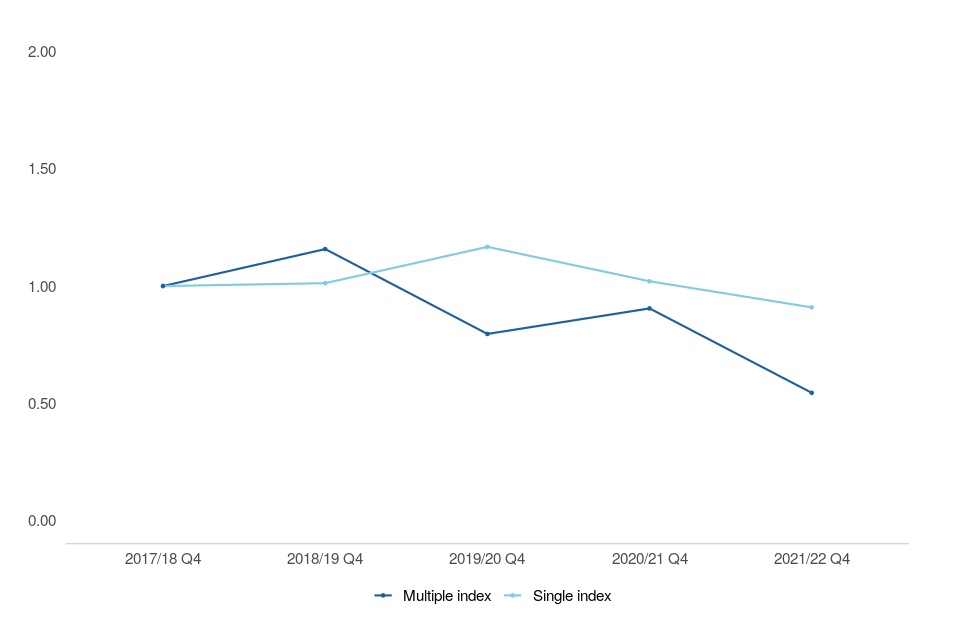
* Baseline 2017/18 Q4
Figure 6.2: Index of Employment Tribunals single and multiple claim disposals, Q4 2017/18 – Q4 2021/22 (Source: Tables S_3)
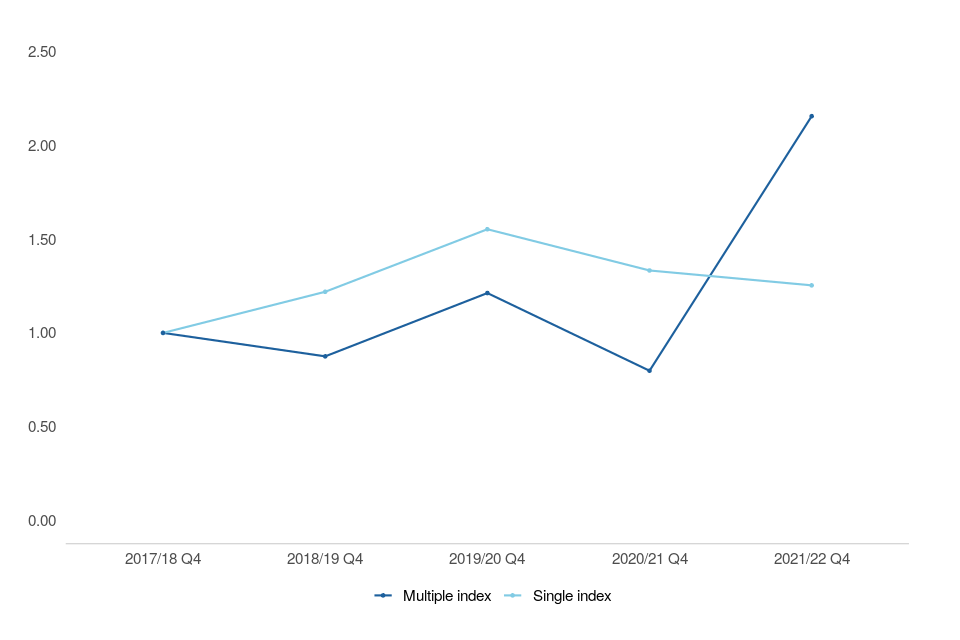
* Baseline 2017/18 Q4
Figure 6.3: Index of Employment Tribunals single and multiple claims outstanding, Q4 2017/18 – Q4 2021/22 (Source: Tables S_4)
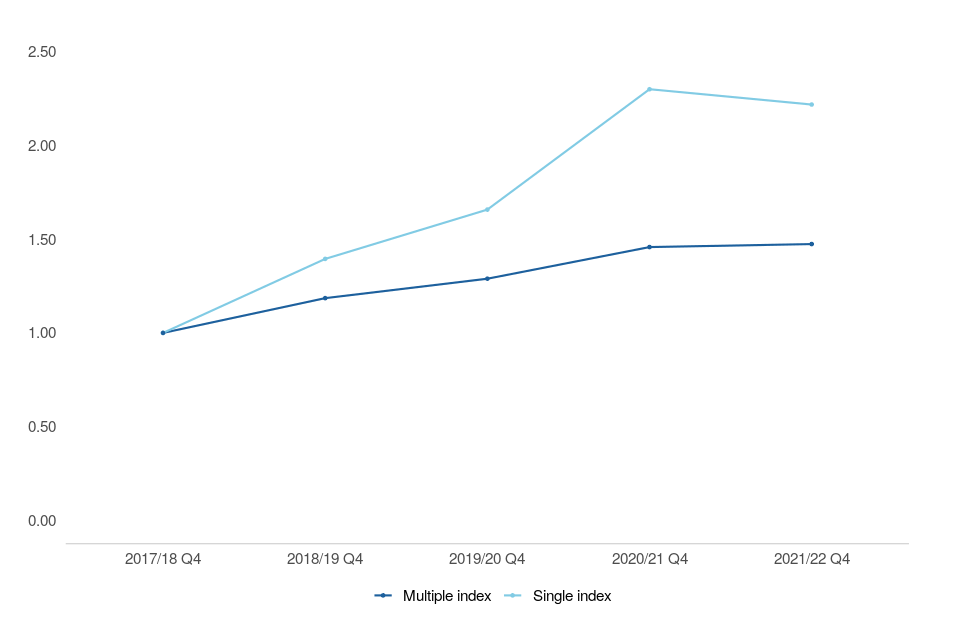
* Baseline 2017/18 Q4
The number of single claim receipts has decreased by 11% to 8,100 in the current quarter, when compared to the same period in 2021, and represents a tapering off following the large rise seen between Q3 2019/20 and Q3 2020/21. Single claim receipts have returned to levels seen prior to the COVID-19 pandemic. Single claim caseload outstanding (at 42,000) continues to rise, having passed the peak levels seen in 2009/10 (when it was 36,000 in Q2 of that year), driven by disposals being continuously lower than receipts.
There were 9,000 multiple claims received this quarter, a decrease of 40% compared to the same period last year. Multiple claims tend to be more volatile as they can be skewed by a high number of claims against a single employer.
The Employment Tribunal disposed of 18,000 claims during January to March 2022, up 56% on the same period in 2021. This was due to a 170% increase in multiple claim disposals (to 11,000).
Employment Tribunal Fee (ET) Refunds
From the launch of the ET fee refund scheme in October 2017 to 31 March 2022, there were 22,000 applications for refunds received and 23,000 refund payments made, with a total monetary value of £18.6 million.
In 2021/22, 22 refund applications were received (down from 83 in 2020/21) and 117 refund payments[footnote 4] were made with a total value of £73,000.
The ET fee refund scheme[footnote 5] was introduced as a phased implementation scheme in October 2017 following the abolition of ET fees on 26 July 2017. Since the introduction of the scheme, a total of 22,000 applications for refunds have been received and 23,000 payments have been made, with a total value of £18,595,000 as at 31 March 2022.
The cumulative number of payments is higher than the number of applications because some applications are fulfilled with more than one payment. In addition, online applications that are processed without manual input are not included in these figures.
In 2021/22, 22 applications were received, 17 (77%) of which related to cases initially brought in England and Wales, while the remaining 5 (23%) related to Scotland. In 2021/22, 117 refund payments were made by the MoJ, with a total monetary value of £73,000. Of these:
-
67% (78 refunds) related to England and Wales, 33% (39 refunds) to Scotland.
-
97% (114 refunds) related to single claims, 3% (3 refunds) related to multiple claims.
Figure 6.4: Employment Tribunal fees – refund applications received, Q4 2018/19 – Q4 2021/22 (Source: Tables ETFR_1)
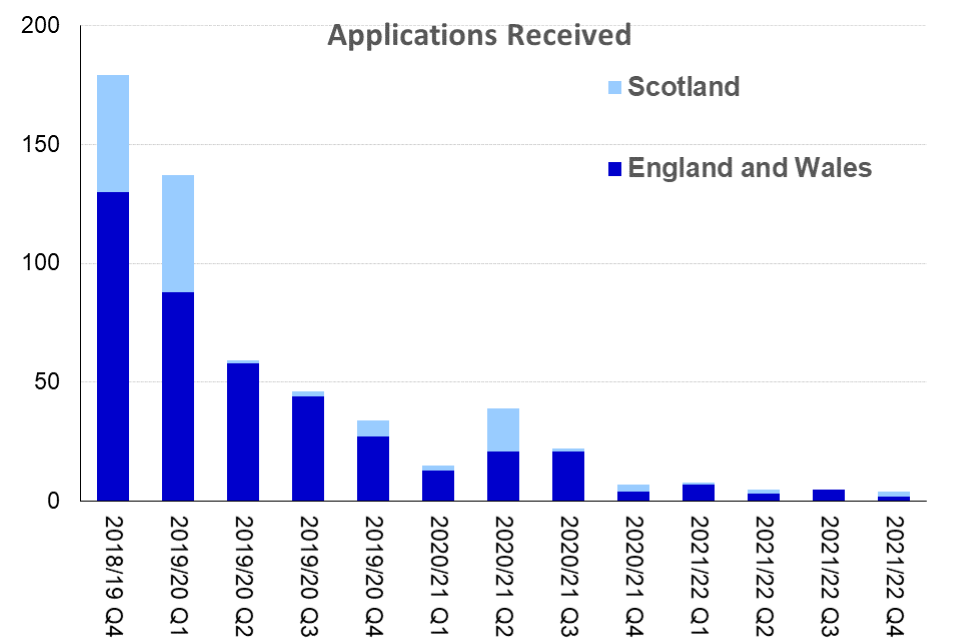
Figure 6.5: Employment Tribunal fees – refund applications processed, Q4 2018/19 – Q4 2021/22 (Source: Tables ETFR_1)
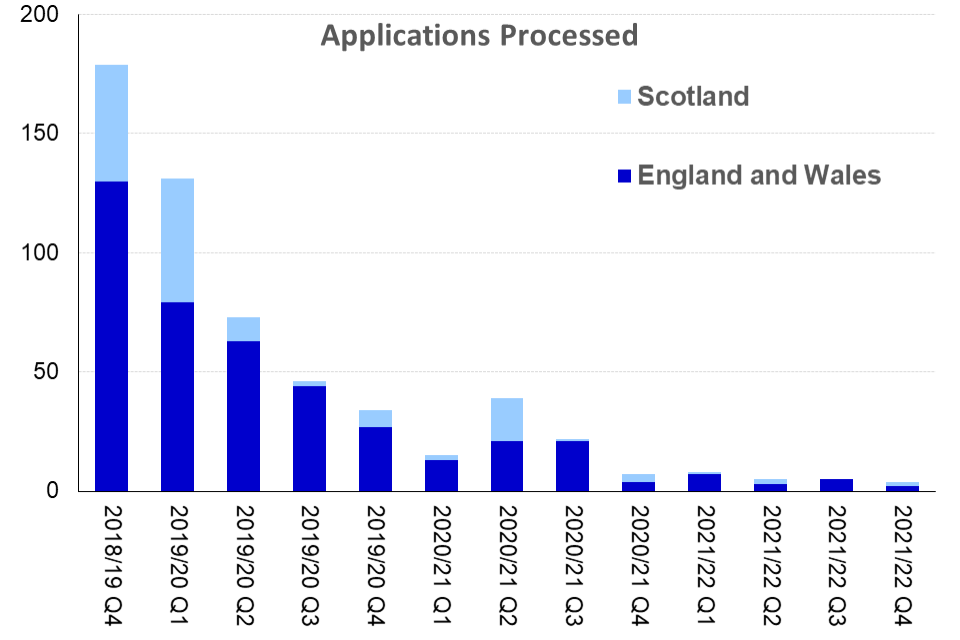
Figure 6.6: Employment Tribunal fees – refund payments made, Q4 2018/19 – Q4 2021/22 (Source: Tables ETFR_2)

7. Gender Recognition Certificates
800 Gender Recognition Panel (GRP) applications were received in 2021/22 and 540 were disposed of between April 2021 and March 2022; 420 applications were pending by the end of March 2022
The number of GRP applications received in 2021/22 was the highest number received in the last 10 years and second highest since records began. (Highest was in 2005/06 at 1,059). Applications received this quarter rose to 200, an increase of 77 compared to January to March 2021. Of the 174 applications disposed of, a full Gender Recognition Certificate (GRC) was granted in 93% of cases (162 full GRCs), the same proportion compared to the same period in 2021 (where 139 full GRCs were granted out of 150 disposals).
GRP receipts have increased annually since 2017/18 and we expect this trend to continue following a reduction in the application fee in May 2021 from £140 to £5, and the move to an online application process. This has subsequently caused an increase in both the caseload outstanding and refusals. Caseload outstanding reached a high of 422 cases in Q4 2021/22, while 3% of all disposals (6 cases) have been refused. Applications can be refused if they do not meet the required criteria. More information on the criteria can be found at the following link: Apply for a Gender Recognition Certificate - GOV.UK (www.gov.uk).
Since April 2005/06, when the Gender Recognition Act 2004 came into effect, 70% of interim certificates (171 of the 243 interim GRCs granted) have been converted to a full GRC, 52% of which were converted within 30 weeks. No interim certificates were converted to a full GRC between January to March 2022. Of the 160 full certificates granted in January to March 2022, 11 were for married applicants and 147 for single applicants. 73 (45%) of the individuals granted full certificates were registered male at birth while 89 (55%) were registered female at birth.
Figure 7.1: Applications for Gender Recognition Certificates received, disposed of and pending, Q4 2017/18 to Q4 2021/22 (Source: Tables GRP_1 and GRP_2)
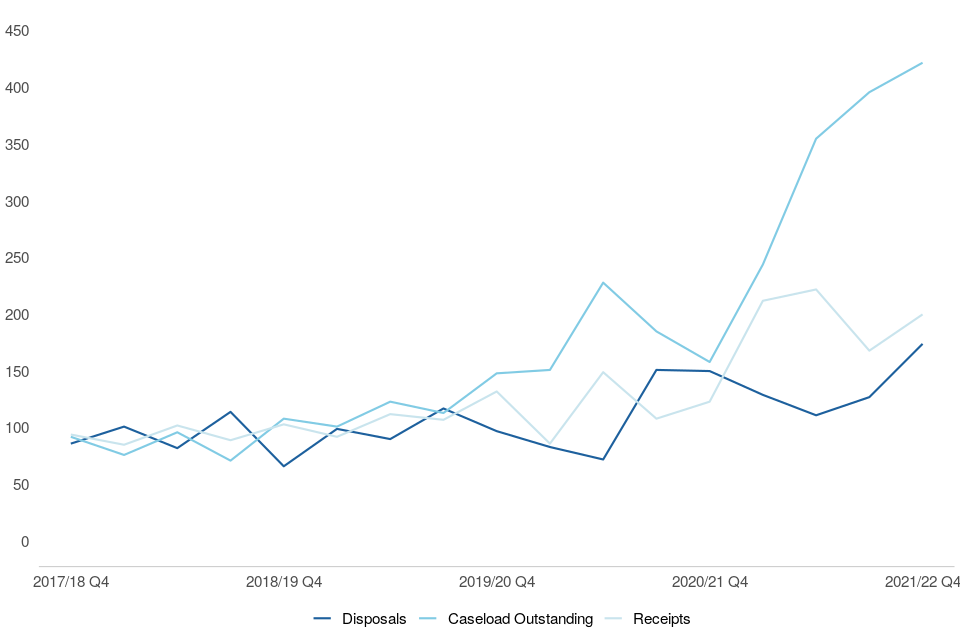
Figure 7.2: Full Gender Recognition Certificates granted by year of birth, 2017/18 to 2021/22 (Source: Table GRP_4)

8. Adjournments and Postponements
Adjournments reported on have decreased by 14% in 2021/22 compared to the previous year, driven by a 25% decrease in SSCS, which represents the majority (70%) of adjournments in 2021/22.
SSCS adjournments decreased from 33,000 in 2020/21 to 25,000 in 2021/22, making up 70% of the 35,000 adjournments in the year. FTTIAC adjournments increased by 105% to 5,300 over the same period.
Postponements reported on decreased by 4% in 2021/22, driven mostly by FTTIAC and SSCS tribunals which represent 10% and 30% of all postponements reported in 2021/22 respectively.
The number of tribunal postponements decreased by 4% to 25,000 in 2021/22, driven mostly by a 12% and 37% fall in FTTIAC and SSCS tribunal postponements respectively.
Social Security and Child Support tribunals had the largest number of adjournments (25,000) which accounted for 28% of SSCS listed hearings (up 1 percentage point on 2020/21). Mental Health tribunals had the smallest proportion of listed hearings that were adjourned – 11% of all Mental Health hearings listed in 2021/22, up 2 percentage points on 2020/21.
The postponement process is different for each tribunal, as such, care must be taken when comparing the postponement figures. As an example, in the SEND tribunal, the case is listed for hearing when the appeal is registered without confirming availability of the parties to attend on that date, whereas in SSCS the date is only set when the parties agree a date. This results in a high number of postponements for the SEND tribunals as the parties may not be able to attend on the scheduled date. This can be for various reasons. These may include holidays; illness; key witnesses unavailable on the date of the hearing; the case simply not ready for hearing or where the tribunal is able to hear an appeal sooner with parties’ consent.
Figure 8.1: Percentage of listed hearings Adjourned and Postponed – SEND, 2020/21 to 2021/22 (Source: Table APJ_1)
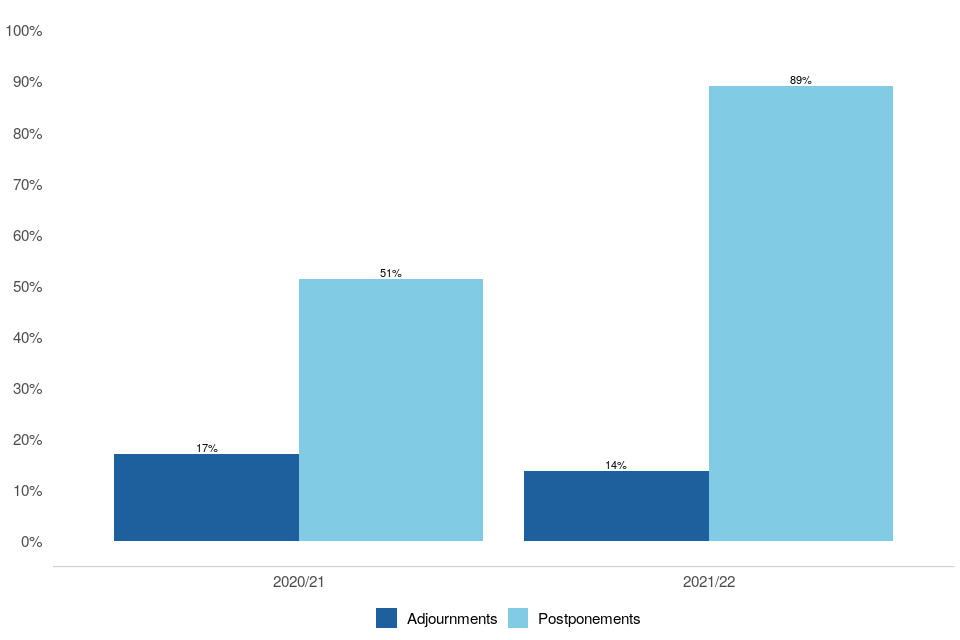
This difference in the process of scheduling involved in the SEND tribunals leads to a relatively large proportion of its listed hearings being postponed - 89% in 2021/22. The number of SEND postponements increased year-on-year, from 620 in 2013/14 to 4,500 in 2019/20. In 2020/21 this number fell to 3,200. This fall was due to the use of remote hearings during the pandemic making attending hearings easier for participants. However, in 2021/22 the number of SEND postponements increased again to 6,000.
Figure 8.2: Percentage of listed hearings Adjourned and Postponed – by jurisdiction, 2021/22 (Source: Table APJ_1)
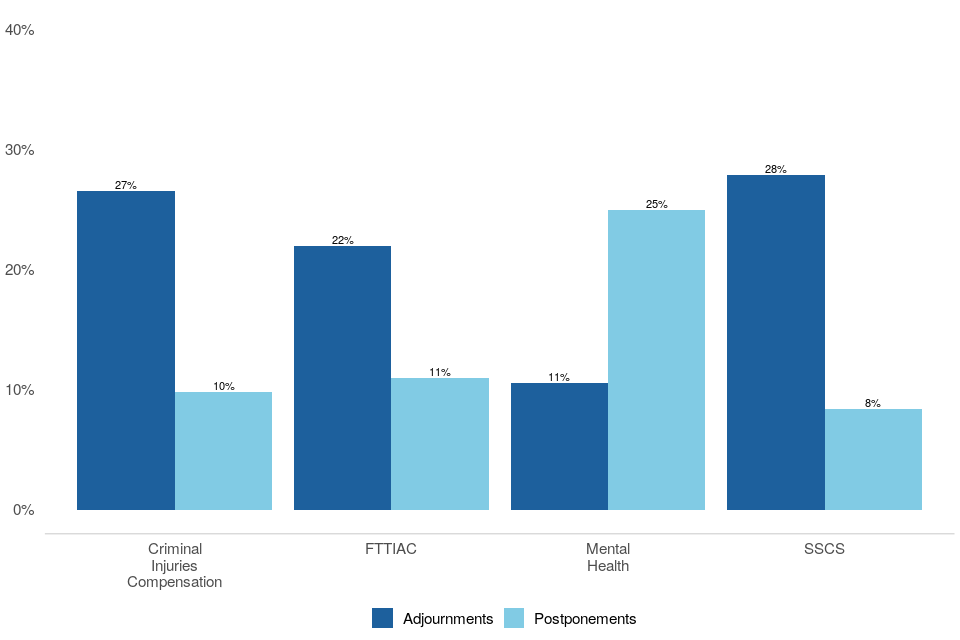
The percentage of SSCS tribunals with postponements has fallen slightly, down from 9% of listed hearings in 2020/21 to 8% in 2021/22. The absolute number of SSCS postponements decreased by 37% to 7,500 in 2021/22. SSCS represented the largest proportion (30%) of postponements. FTTIAC (decreasing by 12% to 2,600) and SSCS (decreasing by 37%) mostly drove the overall decrease in postponements.
9. Tribunal Judicial Salaried and Fee-paid sittings by Jurisdiction
SSCS (27%) and Mental Health (27%) judicial sittings continue to make up a large proportion of all sittings
In 2021/22, there were 46,000 SSCS judicial sittings[footnote 6], down 22% (from 59,000) on 2020/21. In the same period, Mental Health judicial sitting days increased by 8% to 46,000.
The majority of sittings in the Mental Health, FTTIAC and SSCS tribunals were fee-paid.
Fee-paid sittings accounted for 67% of all tribunal judicial sittings in 2021/22, while salaried sittings accounted for 33%. Of the 113,000 fee-paid judicial sittings in 2021/22, 63% were for the Mental Health and SSCS tribunals.
Judicial sitting days at the SSCS continued their downward trend seen since 2018/19, with 46,000 sittings, a decrease of 22% compared to 2020/21. The majority of these sittings were fee-paid (64%).
Mental health sittings increased this year by 8% (to 46,000), of which 89% were fee-paid.
The number of judicial sitting days at the FTTIAC increased by 30% to 13,000 in 2021/22. The proportion of salaried judicial sittings at the FTTIAC increased, down 19 percentage points to 45% in 2021/22.
Figure 9.1: Judicial Salaried and Fee-paid Judicial Sittings 2021/22 (Source: Tables JSFP_1 & JSFP_2)

10. Other Tribunals
Increase in First-tier tax Chamber receipts by 337% in 2021/22 when compared to 2020/21
The First-tier Tax Chamber recorded 21,000 receipts this financial year, an increase of 337% when compared to the previous financial year. In the same period, 7,000 appeals were disposed of and caseload outstanding increased by 49% (to 38,000).
Mental Health receipts, disposals and caseload outstanding all decreased in 2021/22 compared to 2020/21
Mental Health receipts, disposals and caseload outstanding all decreased in 2021/22 when compared to the previous financial year, down by 1%, 2% and 1% respectively.
First-tier Tax Chamber
There has been an increase in all case types in the First-tier Tax Chamber this quarter. Receipts increased by 161%, to 2,800, compared to the same quarter last year. Disposals and caseload outstanding also increased by 2% and 49% to 2,000 and 38,000 respectively. This trend started in Q2 2021/22 and is likely to continue as Treasury and HMRC increase action against umbrella companies employing potentially fraudulent VAT schemes.
Figure 10.1: First-tier Tax Chamber receipts, disposals and caseload outstanding Q4 2017/18 to Q4 2021/22 (Source: Tables S_2, S_3, and S_4)

Mental Health
Mental health figures have remained stable this quarter. Receipts decreased by 2% in January to March 2022 (8,000), compared to the same period in 2021, and in 2019/20, the volume decreased by 2%. The tribunal disposed of 7,900 appeals in Q4 2021/22, a decrease of 2% when compared to both Q4 2020/21 and Q4 2019/20 respectively. There were 3,700 Mental Health cases outstanding at the end of March 2022, down 1% compared to the same period in 2021. The mean age of cases at clearance for the Mental Health section 2, Mental Health Restricted Patients, and the Mental Health Non-Restricted Patients case types has remained consistent for the same period in the last couple of years at 1 week, 12 and 6 weeks respectively.
Nitrates Vulnerable Zones (NVZ)
From April 2016, the Tribunal hears appeals against the designation of NVZs by the Department for Environment, Food and Rural Affairs (DEFRA). The Tribunal is quadrennial and hears appeals in relation to NVZ notices issued once every four years to landowners by DEFRA. The Nitrates Vulnerable Zones appeals are now live again and are reporting figures. In Q4 2021/22, there were 26 receipts and 22 disposals for the Nitrates Vulnerable Zones tribunal. At the end of March 2022, there were 35 cases outstanding. These figures are significantly lower than those seen in Q4 2016/17, which is the first quarter the tribunal was made live four years ago, with receipts 80% lower, disposals 49% lower, and caseload outstanding 60% lower than Q4 2016/17 figures.
Special Educational Needs and Disability (SEND)
In 2021/22 SEND receipts, disposals and caseload outstanding are all at their highest levels since first reporting in 2007/08. When compared to 2020/21, receipts increased this financial year by 24% (to 10,000). Disposals increased by 13% to 8,900 in 2021/22. Caseload outstanding stood at 3,300 as at the end of March 2022, an increase of 24% compared to March 2021. Compared to 2020/21, SEND judicial sittings increased by 8% (to 17,000). A full analysis of SEND figures will be provided in Q2, when the annual set of statistics for the academic year 2021/22 are published.
SEND Rate of Appeal
In the 2021 calendar year, there were 9,200 SEND and 498,000 total appealable decisions, an increase of 17% and 11% respectively when compared to 2020, both reaching the highest recorded level since reporting began in 2014. This gave an overall appeal rate of 1.8% in 2021, up from 1.7% in 2020. This is a similar rate to 2019 and is the highest since 2014.
11. Further information
Rounding convention
Figures greater than 10,000 are rounded to the nearest 1,000, those between 1,000 and 10,000 are rounded to the nearest 100 and those between 100 to 1,000 are rounded to the nearest 10. Less than 100 are given as the actual number.
Accompanying files
As well as this bulletin, the following products are published as part of this release:
-
A supporting document providing further information on how the data is collected and processed, as well as information on the revisions policy and legislation relevant to trends and background on the functioning of the tribunal system.
-
The quality statement published with this guide sets out our policies for producing quality statistical outputs for the information we provide to maintain our users’ understanding and trust.
-
A set of overview tables, covering each section of this bulletin.
-
A set of CSV files including data on two of the three large tribunals (SSCS and Immigration and Asylum) and an overall receipts and disposals CSV, covering all tribunal types.
-
Additional releases this quarter:
-
Update to the statistical notice on Immigration and Asylum (I&A) Detained Immigration Appeals (DIA) to include data to Q4 2021/22.
-
Annual supplementary tables providing the SEND Tribunal rate of appeal at both a national and Local Authority level, calculated as a ratio of appeals submitted to the Tribunals to appealable decisions.
-
Future publications
Our statisticians regularly review the content of publications. Development of new and improved statistical outputs is usually dependent on reallocating existing resources. As part of our continual review and prioritisation, we welcome user feedback on existing outputs including content, breadth, frequency and methodology. Please send any comments you have on this publication including suggestions for further developments or reductions in content.
Contact
Press enquiries should be directed to the Ministry of Justice or HMCTS press office:
Annabelle Kime - email: Annabelle.Kime@Justice.gov.uk
Other enquiries and feedback on these statistics should be directed to the Data and Evidence as a Service division of the Ministry of Justice:
Rita Kumi-Ampofo or Tess Williams - email: CAJS@justice.gov.uk
Next update: 8 September 2022 (URL: www.gov.uk/government/collections/tribunals-statistics)
© Crown copyright Produced by the Ministry of Justice
For any feedback on the layout or content of this publication or requests for alternative formats, please contact CAJS@justice.gov.uk
-
The interim totals for the overall volumes of tribunal receipts, disposals and caseload outstanding exclude the Upper Tribunal (Immigration and Asylum Chamber), Employment Tribunal, and Employment Appeal Tribunal for which the data is currently not available. See the main tables S_2, S_3 and S_4 for more information. ↩ ↩2 ↩3 ↩4 ↩5 ↩6 ↩7 ↩8 ↩9 ↩10 ↩11 ↩12 ↩13 ↩14
-
Outstanding caseload is based on a snapshot in time based on the last day of each quarter. ↩
-
Official statistics overview: Universal Credit statistics - GOV.UK (www.gov.uk) ↩
-
Note that refund payments may relate to applications made in previous quarters. ↩
-
More information on the scheme is available here: Opening Stage of Employment Tribunal Fee Refund Scheme Launched ↩
-
For SSCS, judicial sittings relate to half-day sessions and therefore the SSCS figures are not comparable to the other tribunal sitting days. ↩
